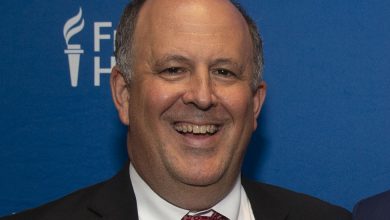Wall Street Grudgingly Allows Remote Work as Bankers Dig In

In her two decades on Wall Street, Nadia Batchelor never once thought she could do her job from home. Face-to-face meetings were a must for Ms. Batchelor, a senior executive at Jefferies, a New York investment bank. Without being in the same room as her clients and colleagues, she assumed, there was no way she could win their trust and do her job of introducing companies to potential investors.
She often woke up at 4:30 a.m. to drive from her home in New Jersey, catch a bus into Manhattan, hop on the subway, squeeze in a workout and get to Jefferies’ trading floor by 7:30 a.m. Work dinners ran late into the night, and redeye flights to London were common.
But after the pandemic forced Ms. Batchelor, a 42-year-old mother of three, to work from home and realize that she could manage just fine, a full return to her grueling schedule is out.
“I was crazy,” she said. “I don’t think that I could go back to it.”
Wall Street is in revolt. Across the financial industry, at firms big and small, workers are slow-walking their return to the office. Bankers for whom working from home was once unfathomable now can’t imagine going back to the office full-time. Parents remain worried about transmitting the coronavirus to their children. Suburban dwellers are chafing at the thought of resuming long commutes. And many younger employees prefer to work remotely.
The reluctance to return to office cubicles is hardly unique to the financial industry. All across America, companies are wrestling with their employees’ demands for flexibility as the pandemic reshapes the future of work. But on Wall Street — known for its hard-charging culture that values face time and long hours, and where toughness is celebrated — it is remarkable.
One reason: Wall Street banks posted record profit and revenue during the pandemic, as government stimulus supported consumers stuck at home and companies sought to do deals, proving to bankers and traders that they have little need to work out of the office the way they used to.
The attendance numbers are low. The financial industry employs 332,100 people in New York City. In October, only 27 percent of those people came in daily, according to data from a survey conducted by the Partnership for New York City, a business advocacy group.
Office attendance at financial-services firms is projected to climb to 47 percent by the end of January as companies lean more heavily on staff, according to the group. Still, that’s a long way off from the 80 percent that was typical before the pandemic, accounting for employees who were traveling, on vacation or sick.
“The bigger institutions are having more difficulty getting people back,” said Kathryn S. Wylde, chief executive of the Partnership for New York City. “From the employer perspective, the longer this goes on, the more difficult it is to get people back, the greater their frustration.”
Some large banks ordered their employees to begin returning to the office over the summer. Top bosses have been saying for months that their clients should be catered to in person, that banking is an apprenticeship business where juniors learn the ropes by observing their seniors, and that teamwork benefits all. Their orders have had mixed impact, leaving bosses flummoxed — and in some cases, vexed.

Nadia Batchelor, a senior Jefferies executive, had a grueling daily commute, and during the pandemic realized it was unnecessary. “I don’t think that I could go back to it,” she said. Credit…Andrew Seng for The New York Times
At an investing conference in June, James Gorman, the chief executive of Morgan Stanley, said: “If you can go to a restaurant in New York City, you can come into the office.” The bank called employees in the New York metropolitan area back after Labor Day. About 65 percent of employees based in Morgan Stanley’s Times Square headquarters are now coming in at least three days a week.
Mr. Gorman has recently taken a more accommodating tone, saying at an Oct. 27 town hall with employees that although spending time in the workplace was essential to maintaining the bank’s culture, “we have learned to function very differently during the pandemic.” He said the bank would allow greater flexibility for workers.
In February, the Goldman Sachs chief executive David M. Solomon called remote work an “aberration” for the company’s traders. The bank asked employees to come back in June. In an emailed statement, Mr. Solomon said Goldman was among the first banks to ask workers to come back, viewing it as essential for its apprenticeship culture. “What is clear through the process is that we are better together than apart,” he said. Still, Goldman’s office in downtown Manhattan is staffed at about 60 percent.
JPMorgan Chase, the largest U.S. lender, required staff to return in rotations starting in July. “People don’t like commuting, but so what?” Jamie Dimon, the bank’s chief executive, told The Wall Street Journal in May. Mr. Dimon has also cited instances in which the bank had lost business to competitors who visited clients in person.
Most JPMorgan employees have returned to the office in recent months, with many of them on hybrid schedules, “just as our senior management team has requested,” a bank spokesman, Brian Marchiony, wrote in an email. “In fact, roughly half of our Midtown employees are working from our offices on any given day.”
In private, many senior bank executives tasked with raising attendance among their direct reports expressed irritation. They said it was unfair for highly paid employees to keep working from home while others — like bank tellers or building workers — dutifully come in every day. Salaries at investment banks in the New York area averaged $438,450 in 2020, up 7.8 percent from the previous year, according to data from the office of the state comptroller, Thomas P. DiNapoli.
Two senior executives, who declined to be identified discussing personnel matters, said they might push out subordinates who are not willing to come back to the office regularly. Another manager expressed frustration about a worker who refused to show up at the office, citing concern about the virus — even though the person had recently traveled on vacation.
Executives “have not felt that they could put on pressure to get people back in the office — and those who have put on pressure have gotten real pushback,” said Ms. Wylde, of the Partnership for New York City. “Financial services is one of those industries that are hugely competitive for talent, so nobody wants to be the bad guy.” She expects that big financial firms will eventually drive workers back into the office by dangling pay and promotions.
For now, banks are resorting to coaxing and coddling.
Food trucks, free meals and snacks are occasionally on offer, as are complimentary Uber and Lyft rides. Dress codes have been relaxed. Major firms have adopted safety protocols such as on-site testing and mask mandates in common areas. Goldman, Morgan Stanley and Citigroup are requiring vaccinations for workers entering their offices, while Bank of America asked only inoculated staff to return after Labor Day. JPMorgan has not mandated vaccines for workers to return to the office.
At Citi, which asked employees to come back for at least two days a week starting in September, offices are about 70 percent full on the days with the highest traffic. Citi, whose chief executive, Jane Fraser, started her job in the middle of the pandemic, has hired shuttle buses so that employees coming into Midtown Manhattan from suburban homes can avoid taking the subway to the bank’s downtown offices. To allay concerns about rising crime in New York, at least one other firm has hired shuttle buses to ferry people a few blocks from Pennsylvania Station to offices in Midtown, Ms. Wylde said.
Remote working arrangements are also emerging as a key consideration for workers interviewing for new jobs, according to Alan Johnson, the managing director of Johnson Associates, a Wall Street compensation consultancy.
Traditional banks haven’t changed their pitch much, he said: “You have to dress up, it’s in the office five days a week, it’s just the 1990s all over again.” In contrast, younger firms offer much more flexibility in working from home, and a relaxed office dress code.
Catalin Vieru joined Silicon Valley Bank, a technology-focused firm in Santa Clara, Calif., in March as a director responsible for moving the bank’s technology to the cloud. His job is fully remote, and he wouldn’t have considered anything else.
Employees have proved that they can work effectively from home, Mr. Vieru said, and for them, “it’s more about a change in attitude that says: ‘You know what? We’re all in this together, we’re all suffering equally from this pandemic.’ Why should I go back to an office and be put back into a corner?”
Jefferies, where Ms. Batchelor works, has embraced hybrid working on a longer-term basis, in sharp contrast with some of its Wall Street peers. It is allowing employees to work at home on solo tasks while also encouraging teamwork and collaboration in the office — and even picking up the tab for group meals.
On peak days, the office is at 70 percent capacity as a result, said Brian P. Friedman, Jefferies’s president. “Our approach has not been one to set a regimen or prescription, but rather to provide support and guidance and allow people to both be trusted by us, and by each other,” Mr. Friedman said.
For Ms. Batchelor, Jefferies’s new policy means coming in to the office three days a week. Although she plans to travel to meetings when necessary, Ms. Batchelor said she was grateful to spend more time with her children and cut back on her long commute.
“I didn’t know what I was missing,” she said.




